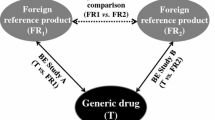Abstract
Biowaivers for class I drugs according to the biopharmaceutics classification system (BCS) were first introduced in 2000. The in vitro equivalence can be used to document bioequivalence between products. This study compared the in vitro dissolution behavior of two BCS class I drugs, amoxicillin and metronidazole, which are sold in China. Identifying a reference product on the Chinese domestic market was impossible. Three 250-mg and two 500-mg amoxicillin capsules and four metronidazole tablet products were tested. None of the amoxicillin products and three of the four metronidazole tablets were found to be equivalent to each other when the same strengths were compared. The bioequivalence of products that fail the in vitro test can be established via in vivo clinical studies which are expensive and time consuming. Establishing nationally or globally accepted reference products may provide regulatory agencies with an efficient mechanism approving high quality generics.



Similar content being viewed by others
REFERENCES
World Health Organization. Country pharmaceutical situations: fact book on WHO level 1 indicators 2007. Geneva: WHO. 2009. http://apps.who.int/medicinedocs/documents/s16874e/s16874e.pdf Accessed 20 Nov 2012.
World Health Organization. Essential medicines and health product. 2012. http://www.who.int/medicines/en/ Accessed 20 Nov 2012.
Food and Drug Administration. Guidance for industry: waiver of in vivo bioavailability and bioequivalence studies for immediate-release solid oral dosage forms based on a biopharmaceutics classification system. U.S. Department of Health and Human Services Food and Drug Administration Center for Drug Evaluation and Research. 2000. www.fda.gov/downloads/Drugs/GuidanceComplianceRegulatoryInformation/Guidances/ucm070246.pdf. Accessed 20 Nov 2012.
World Health Organization. Multisource (generic) pharmaceutical products: guidelines on registration requirements to establish interchangeability. Annex 7 of WHO Expert Committee on Specifications for Pharmaceutical Preparations. Geneva: WHO Technical Report Series No.937, 2006; 40th report: p.347-90. http://apps.who.int/prequal/info_general/documents/TRS937/WHO_TRS_937__annex7_eng.pdf Accessed 20 Nov 2012.
World Health Organization. Proposal to waive in vivo bioequivalence requirements for WHO model list of essential medicines—immediate-release, solid oral dosage forms. Annex 8 of WHO Expert Committee on Specifications for Pharmaceutical Preparations. Geneva: WHO Technical Report Series No.937, 2006; 40th report: p.391-461. http://apps.who.int/prequal/info_general/documents/TRS937/WHO_TRS_937__annex8_eng.pdf Accessed 20 Nov 2012.
Williams RL, Chen ML, Hauck WW. Equivalence approaches. Clin Pharmacol Ther. 2002;72:229–37. doi:10.1067/mcp.2002.126705.
Food and Drug Administration. Orange book: approved drug products with therapeutic equivalence evaluations, 33rd ed. Rockville: U.S. Department of Health and Human Services Food and Drug Administration Center for Drug Evaluation and Research Office of Pharmaceutical Science Office of Generic Drugs. 2013. http://www.fda.gov/downloads/Drugs/DevelopmentApprovalProcess/UCM071436.pdf Accessed 20 Apr 2013.
Spino M, Tsang YC, Pop R. Dissolution and in vivo evidence of differences in reference products: impact on development of generic drugs. Eur J Drug Metab Pharmacokinet. 2000;25:18–24.
Cameron A, Mantel-Teeuwisse AK, Leufkens HG, Laing RO. Switching from originator brand medicines to generic equivalents in selected developing countries: how much could be saved? Value Health. 2012;15:664–73. doi:10.1016/j.jval.2012.04.004.
GBI research. China pharmaceutical market outlook—government incentives, healthcare reform and a rapidly ageing population provide strong stimulus for growth. 2013. http://www.researchandmarkets.com/research/pgk2g8/china Accessed 20 Apr 2013.
Hirschler B. China seen as no. 2 drugs market by 2015. Reuters. 2010 Nov 8 http://uk.reuters.com/article/2010/11/08/us-summit-china-drugs-idUKTRE6A73SL20101108 Accessed 8 May 2013.
Deloitte China. The next phase: opportunities in China's pharmaceuticals market. 2012. http://www.deloitte.com/view/en_CN/cn/ind/lshc/723313bbb0943310VgnVCM3000001c56f00aRCRD.htm Accessed 20 Apr 2013.
Vesiongain. Chinese pharmaceutical market 2013–2023. 2013. http://www.visiongain.com/Report/1018/Chinese-Pharmaceutical-Market-2013-2023 Accessed 8 May 2013.
China Food and Drug Administration. Regulation on drug registration (《药品注册管理办法》) Order 28, 2007.Chinese. http://www.sfda.gov.cn/WS01/CL0053/24529.html Accessed 21 Apr 2013.
Database of pharmaceutical manufacturer (药品生产企业). China Food and Drug Administration, Beijing. 2013. Chinese. http://app1.sfda.gov.cn/datasearch/face3/dir.html Accessed 21 Apr 2013.
China Food and Drug Administration. Annual report of registration and approval of 2011(2011药品注册审批年度报告). China Food and Drug Administration. 2012. Chinese. http://www.sda.gov.cn/WS01/CL0050/75250.html Accessed 10 Feb 2013.
Uniformity of dosage units <905>. In United States Pharmacopeia and National Formulary USP 36–NF 31. Rockville: The United States Pharmacopeial Convention; 2013. p. 431–3.
Zhang Y, Huo M, Zhou J, Zou A, Li W, Yao C, et al. DDSolver: an add-in program for modeling and comparison of drug dissolution profiles. AAPS J. 2010;12:263–71. doi:10.1208/s12248-010-9185-1.
Löbenberg R, Chacra NB, Stippler ES, Shah VP, DeStefano AJ, Hauck WW, et al. Toward global standards for comparator pharmaceutical products: case studies of amoxicillin, metronidazole, and zidovudine in the Americas. AAPS J. 2012;14:462–72. doi:10.1208/s12248-012-9350-9.
World Health Organization. Guidance on the selection of comparator pharmaceutical products for equivalence assessment of interchangeable multisource (generic) products. Annex 11 of WHO Expert Committee on Specifications for Pharmaceutical Preparations. Geneva: WHO Technical Report Series No.902, 2002; 36th report: p.161-80. http://apps.who.int/medicinedocs/documents/s19641en/s19641en.pdf Accessed 20 Nov 2012.
Database of imported drug product (进口药品). China Food and Drug Administration, Beijing. 2013. Chinese. http://app1.sfda.gov.cn/datasearch/face3/dir.html Accessed 20 Nov 2012.
Drug Product Database Online Query. Health Canada, Ottawa. 2012. http://webprod5.hc-sc.gc.ca/dpd-bdpp/index-eng.jsp Accessed 20 Nov 2012.
China Food and Drug Administration. Guideline of development of chemical generics with existing state standard (已有国家标准化学药品研究技术指导原则). China Food and Drug Administration. 2007. Chinese. http://www.cde.org.cn/zdyz.do?method=largePage&id=2076 Accessed 1 May 2013.
Williams RL, Shah VP. Continuing equivalence: is there an end to the story? J Generic Med. 2008;5:297–304.
Wu Y, Fassihi R. Stability of metronidazole, tetracycline HCl and famotidine alone and in combination. Int J Pharm. 2005;290:1–13. doi:10.1016/j.ijpharm.2004.10.015.
Amoxicillin capsules (阿莫西林胶囊). In Pharmacopoeia of the People's Republic of China 2010, vol. 2 (中华人民共和国药典2010版二部). Beijing: Chinese Pharmacopeia Commission. p. 403–4. Chinese.
Metronidazole tablets (甲硝唑片). In Pharmacopoeia of the People's Republic of China 2010, vol.2 (中华人民共和国药典2010版二部). Beijing: Chinese Pharmacopeia Commission. p. 153–4. Chinese.
Database of domestic drug product (国产药品). China Food and Drug Administration, Beijing. 2013. Chinese. http://app1.sfda.gov.cn/datasearch/face3/dir.html Accessed 21 Apr 2013.
Cyranoski D. Pharmaceutical futures: made in China? Nature. 2008;455:1168–70. doi:10.1038/4551168a.
China Food and Drug Administration. View of reforming the drug approval process to encourage drug innovation (Draft) (关于深化药品审评审批改革进一步鼓励药物创新的意见) (征求意见稿). China Food and Drug Administration.2012. Chinese. http://www.sda.gov.cn/WS01/CL0778/77409.html Accessed 1 May 2013.
China Food and Drug Administration. Evaluation scheme of generic quality consistency(仿制药质量一致性评价工作方案). China Food and Drug Administration.2013. Chinese. http://www.sfda.gov.cn/WS01/CL0844/78516.html Accessed 1 May 2013.
Author information
Authors and Affiliations
Corresponding author
Additional information
Guest Editor: Susan D’Souza
Rights and permissions
About this article
Cite this article
Zuo, J., Gao, Y., Bou-Chacra, N. et al. Challenges and Opportunities to Use Biowaivers to Compare Generics in China. AAPS PharmSciTech 15, 1070–1075 (2014). https://doi.org/10.1208/s12249-014-0133-8
Received:
Accepted:
Published:
Issue Date:
DOI: https://doi.org/10.1208/s12249-014-0133-8




